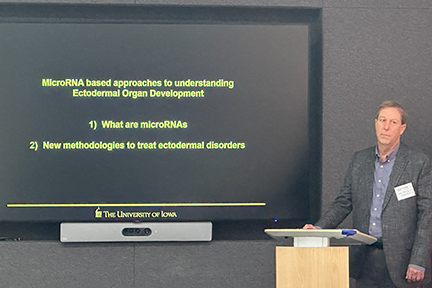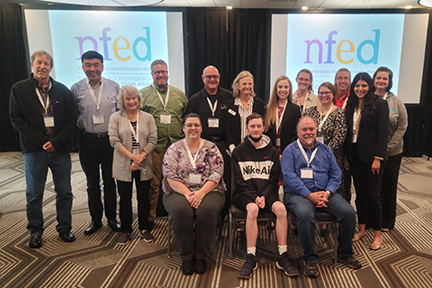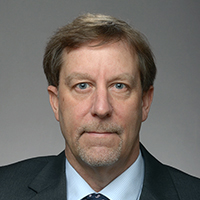The National Foundation for Ectodermal Dysplasias (NFED) is excited to welcome Brad Amendt, Ph.D. to our Scientific Advisory Council (SAC). A longtime friend of the organization, Dr. Amendt brings not only decades of research experience in developmental biology but also a clear passion for helping families impacted by ectodermal dysplasias.
He has participated in multiple NFED scientific conferences, including the recent Complex Wounds in Ectodermal Dysplasias conference and the 2021 International Ectodermal Dysplasias Research Conference.
“I first heard about ectodermal dysplasia 20 years ago,” said Dr. Amendt. “I’ve worked my whole life trying to identify causes for some of these anomalies that we see, especially in children.”
Dr. Amendt is a Professor of Orthodontics at the University of Iowa College of Dentistry and Professor of Anatomy and Cell Biology at the Carver College of Medicine. As Director of the Craniofacial Anomalies Research Center, Dr. Amendt leads a team dedicated to studying how genes and signaling pathways influence the development and regeneration of ectodermal organs like teeth, skin, and hair.
His research explores how genes and signaling pathways guide the development of the face and teeth. It focuses on understanding the molecular basis of genetic disorders. His lab also investigates the role of stem cells and microRNAs in craniofacial development and regenerative medicine.

Through his work, Dr. Amendt and his team are paving the way for new insights and potential treatments for these complex, genetic conditions.
A Natural Fit with the NFED Community
Dr. Amendt’s formal involvement with the NFED began at a conference about five years ago.

“I believe Dr. (Tim) Wright invited several of us within the orbit who were working on different aspects of some of the issues that those with ectodermal dysplasias encounter,” he recalled. “After that first conference, it kind of just steamrolled. It got me more involved with the group, and then I just started to collaborate more and connect with Mary, Becky (from the NFED staff) and the advocates.”
What keeps him coming back?
“We all do this for one reason, and that’s for better health care. And you know we care about people. And you really want to try and help individuals…I just like the group,” he said. “They’re very sincere, and we really want to help people… Everyone (at the NFED) is focused on better patient care and ways to help.”
Tackling Big Problems with New Tools
Dr. Amendt’s research has evolved over the years, from studying human immunodeficiency virus (HIV) and sudden infant death syndrome (SIDS), to gene discovery and regenerative therapies.
“We’ve transitioned from identifying genes involved in hair loss or skin development in mouse models to applying what we learn,” he said. “Now our lab is really involved in tissue, bone, and heart regeneration.”
“Our first application is to regenerate the alveolar bone ridge (what holds your teeth in place). There’s no bone grafting. It’s simple. It’s easy. And it’s non-invasive.”
From there, he’s hopeful this approach could help cleft palate patients and individuals affected by ectodermal dysplasias.
“Some people with ectodermal dysplasia have cleft palate, so we’ve been working with cleft palate kids for quite a long time. We’re trying to heal the palate or the clefting and do it minimally invasively.”
And while in-utero treatments may still be far off, Dr. Amend teases the potential.
“We’re looking at the same type of delivery,” he said. “Maybe it’s a long way away yet for us. But, I think it’s doable.”
A Call for Collaboration

Dr. Amendt suggests that other researchers join NFED efforts to support the ectodermal dysplasias community.
“I would say: do it, very quickly. It is a great organization and they need your help. Everybody has different ideas, and that’s science. Every approach is good. You’d be a valuable member of the community. We want people involved who can look at things and maybe provide some aspect of relief for the different symptoms that people have.”
Dr. Amendt Outside the Lab
Beyond the lab, Dr. Amendt is a proud Midwesterner and environmental advocate with a passion for traveling.
“I’m just a farm kid from the Midwest who grew up loving science,” he said. “I’m an outdoors enthusiast. We do a lot of environmental work in the community, planting trees, giving back. And we love to travel, both internationally and locally. We enjoy life, and we’re happy.”
Looking Ahead
Dr. Amendt’s research is grounded in persistence and hope, two values that deeply resonate with the NFED community.
“You just don’t give up. Even when people say, ‘that can’t work’- yes, it can. We just keep proving it. I think most of us (researchers) are very optimistic, but for a reason.”
We’re grateful to have Dr. Amendt on our team and appreciate the insights he brings to our shared mission.
Have a question or comment? Contact us.
